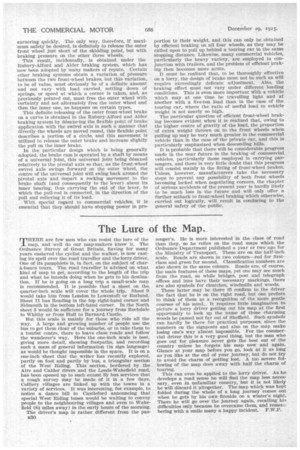The Lure of the Map._
Page 14

If you've noticed an error in this article please click here to report it so we can fix it.
THERE are few men who can resist the lure of the map, and well do our map-makers know it. The Ordnance Survey of Great Britain, Having for many years enslaved the cyclist and the walker, is now casting its spell over the road traveller and the lorry driver. One of its pamphlets is, in fact, on the subject of charit-liancs tours. The road traveller is advised on what kind of map to get, according to the length of the trip and what he intends doing when he gets to his destination. If he is going on a long trip a small-scale map is recommended. It is possible that a sheet on the quarter-inch scale will cover the whole trip. Sheet 9 would take him from London to Lowestoft or Rutland. Sheet 11 has Reading in the top right-hand corner and Sidmonth in the bottom left-hand corner. In the North sheet 3 would lie sufficient for a journey from Rochdale to Whitby or from Hull to Barnard, Castle.
But this scale is mainly for those who ride all the way. A large and growing number of people use the bus to get them clear of the 'suburbs, or to take them to a tourist centre, there to leave class roads and follow the wanderer's way. Here the one-inch scale is best, giving more detail, showing footpaths, and recording such a mass of general information (in sign language) as would be thought impossible in the space. It is on a one-inch sheet that the writer has recently explored, partly on foot and partly by bus, a triangular section of the West Riding. This section, bordered by the Aire and Calder rivers and the Leeds-Wakefield road, has been opened up to such extent l5y bus services that a rough survey may be made of it in a few days. Colliery villages are linked up with the towns in a variety of services. It was interesting, for example, to notice a dance bill in Castleford announcing that special West Riding buses would be waiting to convey people to the neighbouring villages and even to Wakefield (81 miles away) in the early hours of the morning.
The driver's map is rather different from the pas B30 senger's. He is more interested in the class of road than they, so he relies on the road maps which the Ordnance Department published a year or two ago for the-Ministry of Transport. These are on the half-inch scale. Roads are shown in two colours—red for firstclass and green for second. Classification numbers are also shown in the same colours. Roads are, of course, the main features of these maps, yet one may see mach from the road, so while bridges, post and telegraph offices and inns have their necessary markings, there are also symbols for churches, windmills and woods.
These latter may be there '03 confirm to the driver the fact that he is on the right road, but one prefers to think of them as a recognition of the more gentle courses of his mind. It requires little imagination to picture a lorry driver getting out his map at the first opportunity to look up the name of those charming woods he passed not far out of Sheffield. Such symbols can hardly be there for practical purposes, since the numbers on the signposts and also on the map make losing one's way almost impossible. For the commercial driver this is a very good thing, but the man who goes out for pleasure never gets the best out of the country unless he forgets his map now and again. Glance at your map before you go, look at it as long as you like at the end of your journey, but do not try to avoid the charm of getting lost. A too severe following of the map does away with half the charm of touring. This can even be applied to the lorry driver. As he develops a road sense he will find the map less necessary, even in unfamiliar country, but it is not likely he will discard it altogether. The map which was kept folded during the whole of a long journey comes out when he gets by his own fireside on a winter's night. There he will go over the journey again, recalling his difficulties only because he overcame them, and remembering with a smile many a happy incident. F.W.P.






























